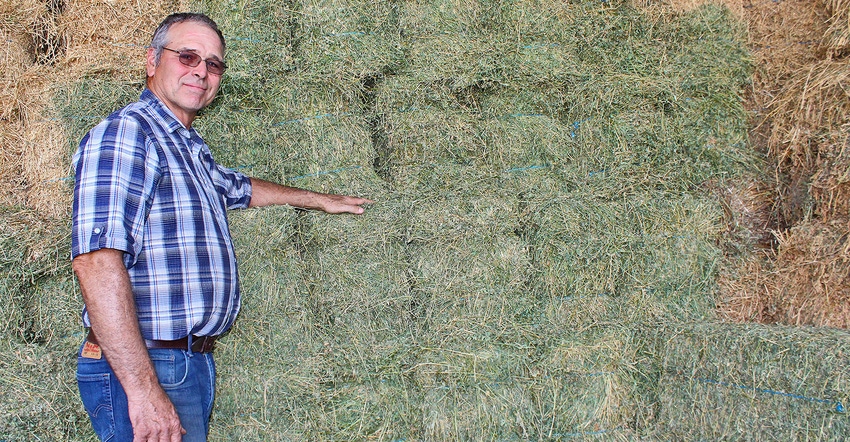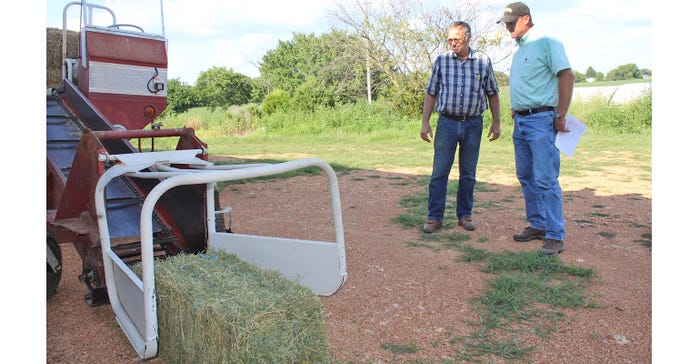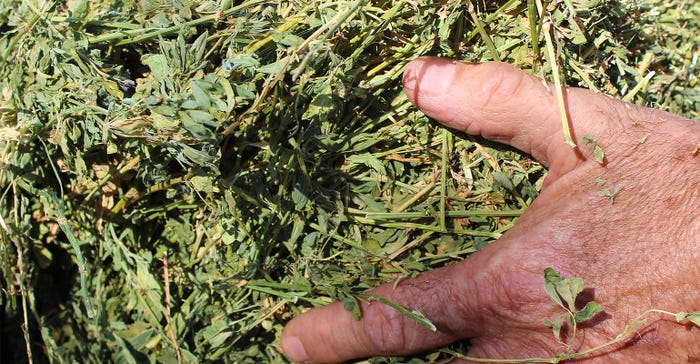
Alfalfa and grass hay producer Glenn Obermann has a winning recipe for quality hay.
The southwest Missouri producer says it is about quality forage, along with time-tested, research-based agricultural and production practices that helps him achieve high scores in relative forage quality (RFQ), total digestible nutrients (TDN) and relative feed value (RFV).
This year, the hay posted RFQ scores of 234.5 and protein of 22.7%. USDA test guidelines consider RFQ greater than 185 to be the highest class, known as supreme. It was enough to earn Obermann, along with his wife Toni, Champion and Reserve Champion awards at the 2018 Missouri State Fair in alfalfa and grass classes 4 to 8, and Champion in alfalfa classes 1 to 3, according to Alan Freeman, agriculture stewardship and development manager for the Missouri Department of Agriculture.
Obermann is no novice at growing alfalfa. He began helping his father in the alfalfa fields when he was 9 years old. He and his father hand-seeded six acres of alfalfa back then. Obermann continued raising alfalfa on his own farming operation. Since 2010, he’s earned seven champion honors — and the awards keep stacking up.
At this year’s Ozark Empire Fair Hay Show in Springfield, Obermann took champion honors in the dry hay show in legumes with an alfalfa-orchard grass mix of WL alfalfa & Crown Royal orchardgrass. It tested at 234.5 RFQ and 60.14 TDN. He, along with his wife Toni, won top honors in five of the last nine years.
Making hay
Obermann grows alfalfa for four years and then no-tills orchardgrass seed into his alfalfa field. This process extends the hay stand for another four to five years. As alfalfa plants age, they die out and leave bare areas. The orchardgrass fills the bare areas and provides weed control.
 MOVING HAY: University of Missouri Extension agronomist Tim Schnakenberg, right, checks out Glenn Obermann’s investment of a self-propelled hay wagon that minimizes handling and eases the workload.
MOVING HAY: University of Missouri Extension agronomist Tim Schnakenberg, right, checks out Glenn Obermann’s investment of a self-propelled hay wagon that minimizes handling and eases the workload.

After this, Obermann plants into a soybean-wheat double crop rotation. He plants alfalfa in the last two weeks of May to the first week of June after danger of frost passes. Alfalfa emerges within three days.
He applies 900 pounds of fertilizer in split applications to encourage growth and maintain persistence. Obermann says high fertilizer levels keep crabgrass and other weeds at bay. "Good fertility is one of his keys to persistence and production," University of Missouri Extension agronomist Tim Schnakenberg says.
Unlike many growers, Obermann uses his own sprayer for time-sensitive applications. This allows a quick response to disease and insects. It also allows him to adjust spray times to wind speeds and weather conditions.
"If you take care of alfalfa," he says, "it comes back."
Proof in production
Obermann cuts alfalfa every 28 days to generate shoots instead of seed. He uses a starter culture inoculant for good fermentation and to boost the hay's shelf life. This allows him to bale at 25% to 26% moisture instead of the recommended 17%. Proper hay moisture is critical to reduce leaf shatter and nutrient loss.
Every part of his hay-making processing runs on time. "It's very time sensitive," Obermann says. "But once you get it figured out, it's kind of fun. If you're going to do something, you've got to do it right."
Hay baling is done at night. By doing this, leaves remain open for a softer, leafier and tastier product. He checks stems for moisture to keep moisture from seeping through and spoiling the hay. As long as stems are dry, dew dampens them and prevents shattering of leaves.
 VALUABLE BALE: Lush, green and leafy hay grown by Glenn and Toni Obermann gains favors with livestock producers for its high relative forage value and high protein content. The Obermanns found a niche market for high-quality small bales.
VALUABLE BALE: Lush, green and leafy hay grown by Glenn and Toni Obermann gains favors with livestock producers for its high relative forage value and high protein content. The Obermanns found a niche market for high-quality small bales.

Most of Obermann's bales weigh 50-60 pounds. "I do not bale 90-pound bales because no one wants to buy moldy hay," he says. "Bales that tight and that heavy simply cannot breathe and could mold."
The process yields an average of five cuttings per season, baling to Dec. 1 after a killing frost. Schnakenberg says conventional hay-baling wisdom suggests Sept. 15 as the last day to cut alfalfa and Nov. 1 after a killing frost. Obermann leaves about a foot of growth at the last cutting.
While making quality forages is labor intensive, Obermann says it is worth it. He has found a niche market for his high-quality square bale alfalfa among horse, sheep, goat, llama and alpaca owners.
"Glenn is an outstanding hay producer," Schnakenberg says. "He puts a lot of effort into it."
Geist writes for the University of Missouri Extension based out of Columbia.
About the Author(s)
You May Also Like




